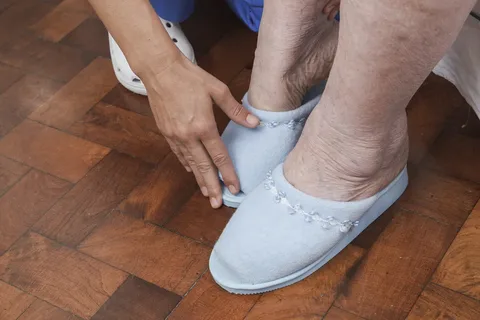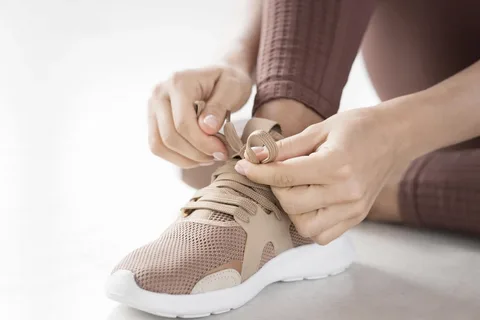Living with diabetes can be challenging, but taking preventative steps can make a big difference. One of those steps is wearing shoes. Wearing shoes are essential to managing the disease, as it helps protect your feet from infections and other complications. This blog post will explore why you should wear shoes for diabetes and what shoes are best for people with the condition. We will also discuss the importance of monitoring your feet and getting regular check-ups with a podiatrist.
Diabetes Can Lead To Foot Problems
Diabetes is a severe condition that affects many aspects of life, including the feet. People with diabetes are at an increased risk of developing foot problems like infection, ulceration, and nerve damage. These problems can be caused by high blood sugar levels, leading to poor circulation in the feet, making them more susceptible to injury.
Diabetes can also affect the nerves, leading to decreased sensation in the feet, making it difficult to feel if your feet are injured or have a foreign object inside them. These foot issues can worsen and lead to amputation without proper care and attention. For those living with diabetes, wearing the appropriate footwear is essential for preventing these types of problems. Not only do shoes protect from debris or objects on the ground, but they can also help protect against excessive rubbing and pressure from activities like walking.
Shoes that are correctly fitted to accommodate any changes in foot size due to swelling can make a huge difference in keeping feet comfortable and protected. If you have diabetes, talk to your doctor about what type of shoes will best suit your needs. It’s important to find shoes that provide plenty of cushioning and support while allowing your feet to breathe. Lastly, check your feet regularly for signs of blisters, cuts, redness, swelling, or sores. Taking preventative steps today could save you from painful complications tomorrow.
 Wearing Shoes Can Help Prevent Foot Problems
Wearing Shoes Can Help Prevent Foot Problems
One of the most important things you can do to help prevent foot problems related to diabetes is to wear shoes. Diabetes can cause poor circulation in your feet, leading to issues such as nerve damage and even amputation if not managed properly. Wearing shoes helps reduce the risk of these issues by providing support and protection to the feet.
Shoes can also provide warmth and comfort, which can help improve blood circulation and reduce the risk of infection. When choosing shoes, it’s essential to pick ones that fit correctly. Shoes should be comfortable and provide support for the arches of your feet. Ensuring the shoes are wide enough for natural foot movement is also necessary. You should avoid wearing high heels, which can put extra pressure on your toes. Opt for shoes with soft soles, providing cushioning and shock absorption while walking.
Finally, it’s essential to keep your feet clean and dry. Wear socks made of natural fibres to help keep your feet dry and reduce the risk of infection. Check your feet regularly for any signs of irritation or cuts, and don’t forget to wear shoes when out in public places. Doing so will help protect your feet from hazards like sharp objects or uneven surfaces.
Wearing shoes can be an essential part of helping prevent foot problems related to diabetes. You can help keep your feet healthy and reduce the risk of developing severe complications with the right shoes and care.
Shoes For Diabetes Can Help Keep Your Feet Warm
Cold temperatures can cause severe problems for people with diabetes, especially in their feet. When you are out in the cold, your feet can become numb and stiff, making walking and performing everyday activities hard. Wearing shoes can help protect your feet from cold temperatures and keep them warm.
A good pair of shoes for diabetes that fits properly and is designed to keep your feet warm is essential for those with diabetes. Shoes with insulation, such as leather or suede, will help keep the cold air out while keeping your feet warm and comfortable.
Additionally, wool socks can be worn to provide an extra layer of warmth while still allowing your feet to breathe. Those with diabetes should avoid synthetic materials such as nylon and acrylic, which do not allow the foot to breathe. People with diabetes should avoid going barefoot, even in hot weather, because of the risk of injury due to nerve damage caused by high blood sugar levels. Even sandals may leave minor cuts on the feet that could become infected.
Also, remember to check your feet each day when putting on new shoes; this allows you to detect any changes before they worsen. It’s also important to wear supportive shoes since they offer more stability while walking. People with diabetes should look for shoes with low heels that provide good arch support and shock absorption. Lastly, ensure your shoes fit properly and don’t rub or squeeze your foot too tight. It helps prevent blisters, sores and other injuries that could lead to infection. By following these simple tips, people with diabetes can stay safe and enjoy life more confidently.
Shoes Can Help Protect Your Feet From Injury
Having a pair of shoes on your feet can help reduce the risk of injury and protect your feet from cuts, scrapes, and bruises. Shoes also help to absorb shocks that come from running and walking. It is essential for those with diabetes, as it can lead to nerve damage and poor foot circulation. Shoes provide a protective barrier between your feet and the ground, which helps to reduce the risk of accidental trauma.
Additionally, wearing shoes can help to reduce the risk of developing a foot ulcer or an infection. While it’s essential to inspect your feet for injuries daily, wearing shoes is still one of the best ways to protect them from accidental trauma. Properly fitted shoes also help prevent blisters, calluses, and bunions. People with diabetes should always wear shoes indoors as well, even if they are at home.
Floors can be cold or uneven; without proper protection, you may not be aware of potential hazards like small objects scattered across the floor. If you’re going outside in the winter, invest in shoes with good insulation against snow and rain. Wearing socks can also help keep your feet warm during colder months. To ensure your shoes fit properly and comfortably, look for a wide-toe box that allows plenty of room for movement so your toes won’t get squished. Also, shop for supportive cushioning that provides cushioning around the heel. Lastly, ensure your shoelaces are secure but not too tight so you don’t cut off blood flow.
Shoes Can Help Reduce Foot Pain
Diabetes can cause nerve damage in the feet, a condition known as peripheral neuropathy. It can lead to decreased sensation, making it difficult to feel pain or temperature changes. As a result, diabetics may be at risk of developing foot ulcers or other injuries that go unnoticed until severe damage has been done.
Wearing shoes can help provide cushioning and reduce pressure on sensitive areas of the feet, helping to reduce pain associated with diabetes-related foot conditions. Additionally, shoes can provide insulation, which helps keep feet warm. Keeping the feet generous help promote circulation, which can reduce pain and discomfort. Shoes can also help provide arch support, helping to reduce strain on the feet and prevent muscle fatigue. Finally, shoes with non-slip soles help reduce the risk of slipping or falling, reducing the risk of further injury. All these benefits of wearing shoes make them essential for managing diabetes and protecting your feet.
Conclusion
Taking care of your feet is essential for managing diabetes, and wearing shoes is an important step. Wearing shoes for people with diabetes is critical for keeping your feet healthy and preventing long-term complications. Shoes help warm your feet, protect them from injury, and reduce foot pain. Investing in shoes designed to accommodate people with diabetes can help ensure your feet remain healthy, comfortable, and safe.
Related Websites:
Articles on Blogshunt
Articles on Blogseu
Articles on Blogspeoples
Articles on Thebigblogtheory
Articles on Allcityforums

